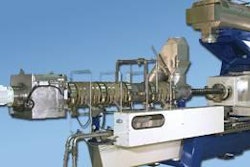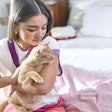
According to Marty Becker, DVM, dogs and cats are in the habit of chowing down whatever has been put in their bowls--leaving them bored, overweight and acting out with behavioral problems. By using food puzzles to feed their pets, consumers allow the dog or cat to work for their food and feel more satisfied, both physically and emotionally, attests Becker.
"Way back before they embarked on their life of leisure in our homes, Canids got their food the old fashioned way-they earned it," says Becker, discussing the change in the way domestic dogs eat. "Swift, strong, and rugged, these canine ancestors spent many hours each day pursuing prey in a never-ending quest to fill their rumbling bellies. Getting food took skill and cunning, utilizing the brain as much as physical attributes."
In the wild, canids spend about 60% of their waking hours attempting to obtain food. This produces physical exercise and mental stimulation. Feeding a dog its entire day's food in one sitting without any effort or mental stimulation effectively short-circuits nature's design, according to AnimalBehavior.net , a web-based service that helps consumers with their pet's behavioral problems. This under utilization also leaves them feeling bored, and more prone to develop psychological problems. "Boredom often leads to dumb, fat, frustrated pets," says Dr. Rolan Tripp, the founder of AnimalBehavior.net. "Dogs weren't bored when they had to work for food."
The question now becomes, how can pet owners substitute something else to obtain that physical and mental stimulation? The best answer is to start feeding from petfood puzzles and allow hunger to be the motivation to play and eat, claims Becker. Many pet owners are beginning to feed all home food from puzzles instead of bowls, and reporting great success on consumer websites and blogs.
What are petfood puzzles? A "petfood puzzle" is any toy or object that can contain food, and requires the pet to work to find a way to obtain the food. The reason for pet parents to feed from petfood puzzles instead of bowls is to entertain and occupy the pet's mind during the day, keeping them quiet and focused, instead of jumping, scratching, barking or biting.
The most common food puzzles, and perhaps one of the first on the market, are the Kong branded toys and treats. The company makes products for puppies, adults and seniors, as well as toys and treats made for toy to giant breeds. There are Kongs with dry kibble inside, Kongs with frozen canned food that slowly melts and Kongs with an inch of peanut butter smeared just inside the opening. The award-winning Kong Stuff-A-Ball is a natural rubber treat-dispenser and dental toy. As the dog rolls, bounces or chews the Stuff-A-Ball, it will periodically release food or treats. The resulting rewards ensure longer enriching playtimes, according to KongCompany.com. When used as directed, the Stuff-A-Ball will engage and stimulate the dog, while reducing boredom, destructive behaviors, and separation anxiety.
There are many other brands and types of food puzzles available. Other options Dr. Tripp recommends:
- Buster Cube: A hollow, large dice made out of hard plastic;
- Busy Buddy Toys: Wide variety of treat dispensing toys, as well as toys for cats;
- Canine Genius: Durable, chewable, configurable puzzles that you can stuff with tasty treats;
- Crazy Ball: Rubber rolling ball that's big dog tough; and
- Molecuball Treat Ball: Soft vinyl is quiet on the floor and easy to hide around the house.
Food puzzles vary in the difficulty of getting the food out, and some are adjustable and need to be customized to the dog's weight and personality. For starters, Tripp recommends starting with easy food puzzles for dogs that are thinner, easily frustrated or just learning the new concept. For overweight or clever dogs, harder food-puzzles like linked Canine Genius or the Buster Cube are recommended. Consumers can also hide a pet's food around the house by sneaking a puzzle like the Molecuball under a bed, or behind a sofa.
Animal behaviorist and animal training publisher Ian Dunbar, PhD, MRCVS, says that by not allowing pets to pursue and earn food, we steal their life. "Without a doubt, regularly feeding a new puppy (or adult dog) from a bowl is the single most disastrous mistake in dog husbandry and training. Within seconds of gulping, the poor dog now faces a mental void for the rest of the day with nothing but long, lonely hours to worry and fret, or work itself into a frenzy," says Dunbar.
Watching a pet work so hard to eat can often have consumers worried they may be frustrating the animal. Behaviorists call this food motivated exercise, "constructive discontent." Tripp says, "We can treat boredom using constructive discontent (hunger) to expend energy, and stimulate intelligent problem solving, resulting in pets that are physically healthy, smarter, and more emotionally fulfilled."
Not all dogs and cats benefit from food puzzles, so consumers should consult a veterinarian before changing the way their pets eat. Companion animals that are thin, poor eaters or sick, often do not have the motivation to work to get the food out, and may lose weight. Petfood puzzles are most beneficial for pets who are healthy, bored, active, and especially those that pace or bark.
This feeding method is not usually helpful for territorial, fearful, threatening or food possessive barkers, however.
Providing an enriching and stimulating environment is an important factor in raising a healthy, well-adjusted pet. Although feeding an animal by bowl at regular intervals will satisfy the animal's nutritional needs, it does nothing to address the animal's psychological and intellectual needs. Adding interactive-feeding sessions to a pet's normal feeding schedule will be a rewarding and educational for not only the pet, but the consumer as well.













